Jessica Wilson struggled for a year with the continuous positive airway pressure (CPAP) mask that she used to treat her obstructive sleep apnea (OSA). Despite her best intentions, wearing the mask that delivers oxygen and prevents airway obstruction didn’t work for her.

“I would take it off at night not even realizing that I had done that,” she said. “I just wasn’t getting any kind of benefit from wearing that.”
That’s when she found out about a new kind of treatment for sleep apnea that became available at Vanderbilt University Medical Center (VUMC) last year for patients unable to succeed with CPAP therapy. It’s called hypoglossal nerve stimulation, and uses an implantable device that acts like a pacemaker for the tongue to prevent airway obstruction.
VUMC is the only institution in Middle Tennessee offering the treatment and one of only two in the state, said David Kent, MD, assistant professor of Otolaryngology, who performs the surgery. He works closely with colleagues in the Sleep Disorders Program at Vanderbilt to identify and treat eligible patients.
“With Dr. Kent being a part of the Vanderbilt Sleep Center, we are able to provide a more comprehensive treatment approach for obstructive sleep apnea,” said Huong Pham, MD, assistant professor of Neurology at the Vanderbilt Sleep Center. “For patients like Mrs. Wilson, who failed multiple medical therapies for her sleep apnea, we are able to provide extra treatment options, such as hypoglossal nerve stimulation.”
Once surgically implanted, the device sends an impulse to the hypoglossal nerve during sleep, gently pulling the tongue away from the back of the throat and relieving airway obstruction. It also eliminates the need for CPAP.
“It’s probably the best thing I’ve ever done, surgery-wise, just because my quality of life,” Wilson said. Before treatment for sleep apnea, she said, she was tired all the time, and suffered from depression.
“I would have to take naps on the weekends,” she said. “I would have to drive a lot across the state for my job and I would feel like I was going to fall asleep at the wheel all the time. Once I came home from work I had zero energy to play with my son… I didn’t have energy to cook or clean or anything. It was just very depressing. I didn’t have a life.”
With the treatment, her energy level has rebounded. “Now that I’ve got more energy I’ve been able to work out at least four times a week,” she said. “The depression has gone away.”
Sleep apnea is a very common medical problem, affecting around 30 million U.S. adults, Kent said.

“The long-term data shows that sleep apnea, especially severe sleep apnea, is independently associated with a whole host of very common medical problems — high blood pressure, diabetes, increased risk of heart attack and stroke and, in some populations, even increased risk of early death,” Kent said.
“Sleep apnea and poor sleep are associated with mood disorders, and being sleepy during the day increases the risk of workplace accidents and decreased work productivity. It also increases significantly the risk of motor vehicle accidents if it goes untreated.”
Kent said the new sleep apnea device is intended for patients with moderate-to-severe sleep apnea who can’t find success with CPAP. The patient must meet other additional criteria in order to be a candidate for implant, including having the appropriate anatomy.
CPAP therapy is still the gold standard for treating obstructive sleep apnea.
However, not all patients are able to tolerate it or gain benefit from it. Some patients are able to use it for only part of the night, not getting its full benefits.
“A good part of my practice is identifying barriers to CPAP use, and either medically or surgically trying to improve the ability for someone to benefit from CPAP,” Kent said. “But if they can’t, we’ve got some other cards in our pocket, like the hypoglossal nerve stimulator, that they may potentially be candidates for.”
The treatment requires a surgery with three small incisions — on the side of the neck, on the chest wall below the clavicle and on the patient’s side.
The neck incision is used to attach a stimulator cuff to the nerve that controls the tongue. The cuff is attached to the battery on the chest wall and the breathing sensor on the patient’s side.
“The postoperative recovery experience tends to be much easier for patients than some of the other surgeries that we do for sleep apnea,” Kent said. “Most people are back to their regular lives after about two weeks.”
The patient turns the device on at bedtime with a remote control. After they fall asleep, it begins to work until the patient wakes again in the morning.
Ron Eavey, MD, Guy M. Maness Professor and chair of Otolaryngology and director of the Vanderbilt Bill Wilkerson Center, talked about the collaboration between the Vanderbilt Sleep Center and the Vanderbilt Bill Wilkerson Center that offers patients multiple avenues to treat sleep apnea.
“A wonderful aspect of Vanderbilt is the ability of departments to work together to optimize patient care,” he said. “Sleep is a prime example of a condition that historically was underappreciated. Now with multidisciplinary focus, the patient can be offered an array of contemporary options to improve health.”
For more information about hypoglossal nerve stimulation, email inspirecoordinator@vanderbilt.edu or call 615-936-3002.

















